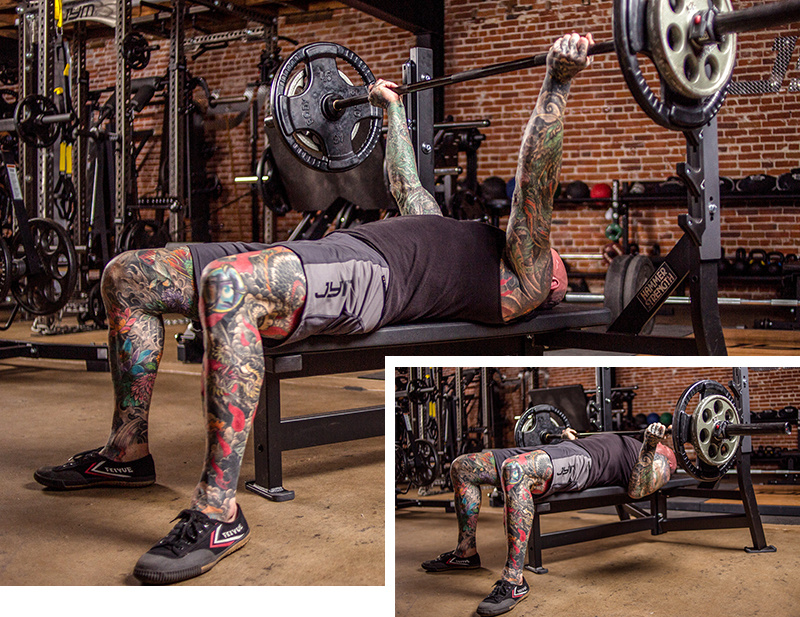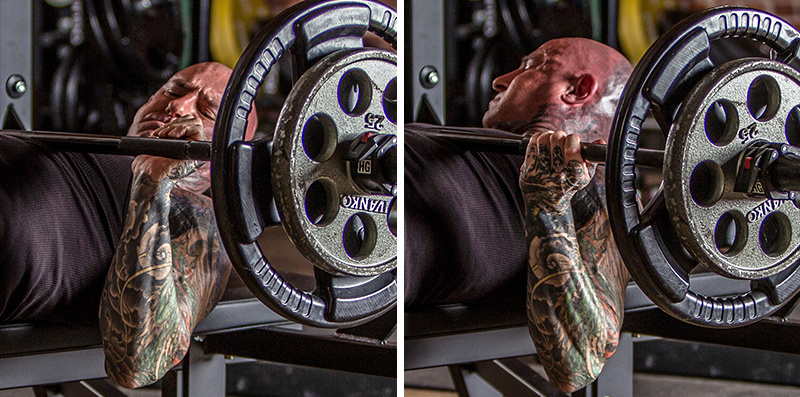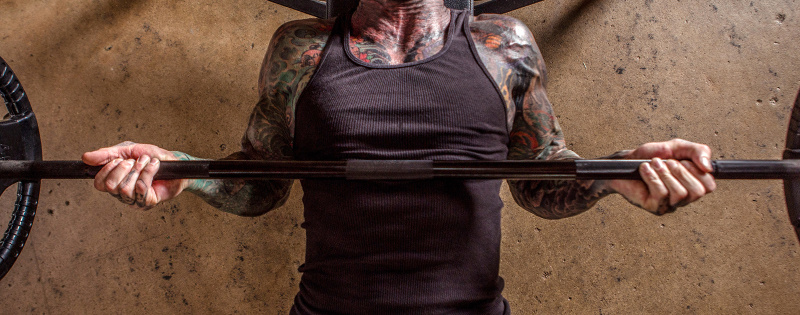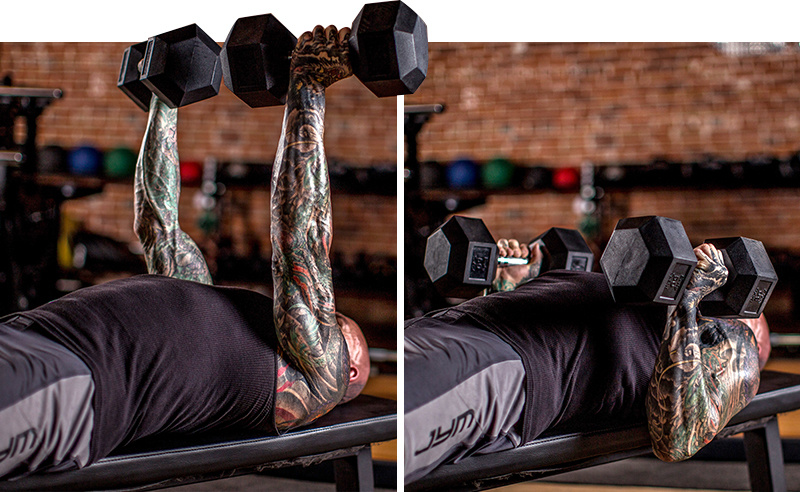Reverse Grip Bench Press Master Class
Perfect your technique on the reverse-grip bench press to maximize upper chest development.

Perfect your technique on the reverse-grip bench press to maximize upper chest development.

GET MY SHORTCUT TO SHRED WORKOUT
The reverse-grip bench press may not seem like an upper chest move, because it’s done on a flat bench, but it absolutely is – science proves it.
One study showed that using a reverse grip on the bench press – flat bench, not incline – increased subjects’ upper pec activity by 30%. And when you go from a flat bench to an incline, it’s supposed to hit the upper pecs even more, right? Yes, it does. But research has shown that it's only a 5%-10% increase. (However, the front delt activity increases by over 30%.)
Now, compare a flat bench press to what most consider “the standard” for upper pec development, the incline bench press. Muscle activity only goes up by about 5%, maybe 10%, on the incline. On the same bench – a flat bench – just by flipping your grip to a reverse grip, it increases the upper pec activity by 30%.
Long story short, if you're trying to hit more of the upper pecs, reverse-grip bench press NEEDS to be a part of your chest-training repertoire. If you want to stick with the incline bench, that's fine. Just know that if upper pec development is a problem for you, the reason might just be that you're focusing on the incline versus using the reverse grip on presses.
Look at the below set of photos. The arms are coming up and forward, and that's helping hit more of the upper pecs – versus when the elbows come out to the sides more and then in, which hits more of the middle and lower part of the pecs.

By simply flipping your grip, it tucks those elbows in, which is helpful for protecting the shoulder joints. So, two main differences between reverse-grip and standard bench press is (1) reverse-grip hits more of the upper pecs, and (2) it does a better job of protecting the shoulder joints.
Before I break down the exercise technique in greater detail, here’s a brief description of how to do the reverse-grip bench press:
As the name implies, the reverse-grip bench press is simply the bench press done with an underhand grip (“underhand” and “reverse-grip” are synonymous). The standard bench press, on the other hand, is done with an overhand grip, and it’s a great exercise for hitting the middle pecs.
Getting in position to do barbell reverse-grip presses is simply a matter of flipping your grip to underhand. But if you’ve never done the exercise before, this can be a bit tricky. The one thing you DON’T want to do is take a reverse-grip while the bar is racked. If you train alone, or even if you have a training partner, this is a poor way to set up for the exercise, because the bar is too far back in relation to your chest behind you – it may be out over your forehead, or even beyond your head. So, don't try to unrack the bar with a reverse grip.
Instead, try my method, where you take the bar with an overhand grip, bring it down to your chest, support it with your chest, and balance it with your hands. At this point, simply switch your grip to an underhand grip – and now you're in reverse-grip position.
Here are a couple photos of me flipping from an overhand grip (photo on left) to a reverse-grip (right) at the beginning of a set:

Research shows that you want a grip that’s slightly wider than shoulder-width. Now, if you're using the biacromial technique (as you would when doing a standard bench press), wider-than-shoulder-width doesn't really apply.
But if you want to de-emphasize the triceps – which reverse-grip presses used to be known for, as a triceps exercise – and hit more of the upper pecs, position your hands a bit outside of shoulder-width when you’re getting them situated at the beginning of the set.
When you lower the bar from the up position, don’t bring it down to your chest or to your nipples like you would with a standard bench press. The bar should actually touch down below your chest. The line of your lower pecs, where the upper abs are, is about where you should come down to, if not even a bit lower on your abs.
The exact point to bring the bar down to is going to depend on your biomechanics and your arm length, so find what’s comfortable. But you want to be coming down low, not up high, to execute the proper path of motion.
In the below picture, you’ll see that the bar is touching just below my chest.

Remember, with the bench press (this variation included), you shouldn’t be pushing the bar straight up. The motion should be a bit of an arch; the bar should come back toward your head. The reverse-grip maximizes that movement of the arm, that arc, and that's what’s really helping to hit the upper pecs.
One question I often get is: “Is it better to use an open grip or a closed grip when doing the reverse-grip bench presses?"
That doesn't really matter here. It all has to do with the way the bar sits in your hand. The bar sits in your hand completely different when you do a reverse-grip bench press as compared to the overhand standard bench press.
With the overhand grip, if you're using a closed grip, what tends to happen is, because the thumb sits under the bar, it pushes the bar up on the hands. As a result, the bar sits higher on the hand, meaning you have more flexion and extension at the wrist while you're benching. This makes it unstable and lessens the force production to the bar from your arms.
When you switch to an open grip, the thumb is out of the way. Now the bar can sit lower on the hands and the force comes directly up through the forearms into the bar.
When you do a reverse-grip, the way you hold the bar, it’s angled – it actually sits at a 45-degree angle in your hands. Your hands aren't completely at a reverse-grip unless you have the flexibility to really flip your grip. Most people are going to find that it’s coming at an angle in the hands and, because of this, where the thumb sits doesn't really matter.
You could use an open grip if that’s what you prefer, or a closed grip. I would probably err on a closed grip because most people aren't accustomed to doing this exercise and, with the open grip, if it falls out of my hands it’s going to come back toward me. When I'm doing an overhand grip on the bench press, at least if it falls out of my hands it’s not falling toward my face; it's falling toward my torso. Not that that's a great situation either, but in the worst-case scenario, I’d rather have a bar falling toward my torso than my face.
If you find that it’s more comfortable to take an open grip – if it doesn't slip for you – that's fine. But if you're getting used to this exercise, wrap the thumb around the bar (closed grip) to be safe.
Now, one thing that I'm a big proponent of is finding exercises that work for you. Let’s say you don’t have a barbell and you want to do one of my programs with dumbbells instead. That’s totally fine. You can swap out any barbell exercise – including reverse-grip bench press – with the dumbbell version of the movement.
Dumbbell reverse-grip bench is a good option if you find it awkward to position your hands with the barbell, or if your wrists or shoulders bother you on the barbell version. With dumbbells, each hand is free and the movement is a bit smoother, so you may very well prefer it.
As with the barbell version, you can do the dumbbell version on an incline bench if you want. The reverse-grip will obviously help you target the upper chest, but will the incline help even more? I can’t say for sure, but I’ve gotten feedback from people saying they’ve gotten great results in bringing up the upper pecs using not only the reverse-grip bench press, but the reverse-grip incline press.
With dumbbells, it’s the same concept as with the barbell version. Although I use an open grip when I do standard dumbbell presses with an overhand grip, with a reverse-grip I use a closed grip due to the way the dumbbells sit in my hands. There's no real benefit to using an open grip, due to the way you're pressing with a reverse grip (as I explained above).
The nice thing about the dumbbells is that you don't need a completely reversed grip. You can probably go with somewhere around a 45-degree angle with your hands.
When you come down, you're going to bring the dumbbells down so that they’re at about a 45-degree angle with your torso; you can even go with a neutral grip in the bottom position (as I’m doing in the below photo). As long as you're not using an overhand grip, which is a different exercise (a standard dumbbell press). Anywhere between neutral and reverse is going to get the same benefit.

From the bottom, you're going to press the weights back up in an arching motion. Just like with the barbell version, I'm bringing the dumbbells down so that my hands end up below my chest, and then I'm pressing it back up toward my face. That arching motion is helping to hit those upper pecs.
GET MY SHORTCUT TO SHRED WORKOUT
Related Articles